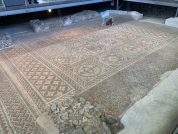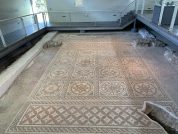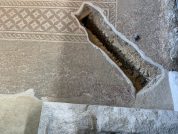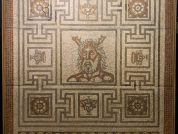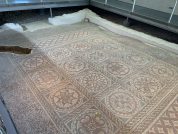Verulamium Hypocaust and Mosaic
Roman Houses
Sitting a short walk from the internationally recognised Verulamium Museum is the Hypocaust. Located within Verulamium Park, this ancient underfloor heating system is a marvel of Roman engineering and an excellent example of the first indoor heating systems installed in Britain.
The modern building is built over the surviving foundations of part of a roman town house. It was excavated by Dr Tessa Wheeler and Dr Norman Davey. The mosaic floor forms just one of the rooms of the great house 60 m long, with at least 30 rooms on two storeys. The floor is thought to have been part of the reception and meeting rooms of a large town house, built around AD 200 near Watling Street, the major Roman road that ran past Verulamium.
It was just one of the many large masonry houses built around this tie, after a catastrophic fire destroyed many of its earlier wooden buildings.
Roman hypocaust systems allowed hot air to circulate beneath the floor and through the walls of buildings. Floors were raised on brick columns (pilae) or, as in this case, trenches were cut below the floor to allow the hot air through. The mosaic covering the hypocaust was made of tesserae (small cubes) of cut stone or tile. These were set into a thin layer of fine mortar which was spread over a concrete floor. The tesserae were grouted with mortar and polished with abrasive stones. The floor may have also been polished with beeswax to enhance the colours.
Today, the Hypocaust is housed within a sleek modern building and is free to visitors.
Sites near Verulamium Hypocaust and Mosaic
- St Albans (Verulamium) Roman Settlement (0 km)
British Capital and Flavian Auxiliary Fort (AD 69–96) - Saint Albans (Verulamium) Fort (0 km)
Claudian Auxiliary Fort (AD 43–54) and Flavian Auxiliary Fort (AD 69–96) - St Albans (Verulamium) Theatre (1 km)
Theatres - Gorhambury Rural Villa (2 km)
Villa - Park Street Villa (4 km)
Villa - Wheathampstead Hillfort (8 km)
Iron Age Hillfort - Gadebridge Park Villa (9 km)
Villa - Boxmoor Roman Villa (10 km)
Villa - Brockley Hill (Sulloniacae) Roman Settlement (12 km)
Claudian Auxiliary Fort (AD 43–54), Pottery and Vicus - Welwyn Settlement (13 km)
Major Settlement
